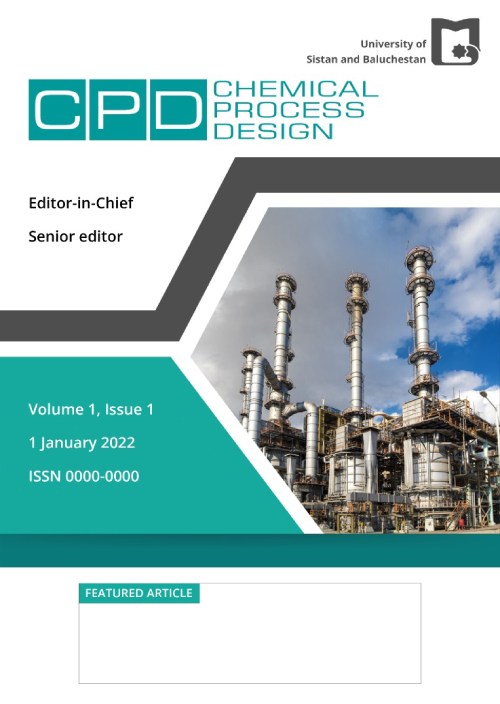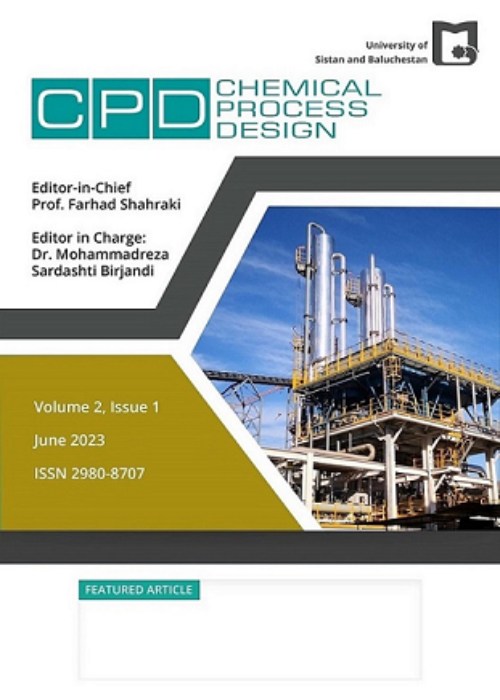فهرست مطالب

Chemical Process Design
Volume:1 Issue: 1, Jun 2022
- تاریخ انتشار: 1401/10/14
- تعداد عناوین: 6
-
Pages 1-16Refineries and petrochemical industries can transform some of their flare gas into noteworthy gasoil, gasoline, and LPG products by applying technology of Gas-to-Liquid (GTL). One of the main parts of GTL plant is the production of synthetic gas process. As the main objective of this study, two technology steam methane reforming (SMR) and tri-methane reforming (TMR) techniques have been used to simulate and analyze the proposed sensitivity of the new integrated GTL process. Therefore, four parameters have been studied in sensitivity analysis against changing the proportion of gas recovery to gas synthesis and amine subunits. Therefore, four parameters have been studied in sensitivity analysis (SA) against changing the proportion of gas recovery to gas synthesis and amine subunits. SA results represented that raising recycle gas ratio has negative impact on SMR model productivity and has positive effect on TMR model productivity, especially between 0.0 to 0.7 ratios. Also, the decreasing trend of the syngas production rate in the SMR was much more severe and with a greater slope than the increase in the syngas production rate in the TMR. Therefore, on this basis, the final productivity in the integrated process also shows a significant increase about by using the TMR process (3835 kg/hr.) versus the SMR process (3793 kg/hr.).Keywords: Gas-to-Liquids (GTL), Steam Methane Reforming (SMR), Tri-Methane Reforming (TMR), Sensitivity analysis
-
Pages 17-26
Selective extraction of Mo from the spent HDS (Hydrodesulfurization) catalysts was studied using Cyanex272 extractant. The required experiments were designed by RSM (Response Surface Methodology) method according to CCD (Central Composition Design), and four independent parameters were examined, including Cyanex272 concentration, H+ concentration of leach solution, temperature, and Mo concentration in the leach solution. A quadratic equation was derived for the prediction of Mo recovery with R2 equal to 0.98, which verified this equation for fitting the experimental results. The value of Mo recovery in different conditions showed that the effect of the leach solution acidity is insignificant at a low concentration of Cyanex272. The optimum value for Cyanex272 concentration, H+ concentration of leach solution, temperature, and Mo concentration was obtained at 0.27 M, 3.4 M, 30 ˚C, and 279.74 mg/L, respectively. The Mo recovery was 99.05% in these conditions, which had a 0.74 error from the software predicted value.
Keywords: Molybdenum, HDS catalysts, Solvent extraction, Response Surface Methodology -
Pages 27-32
Packed towers are continuous contact systems in which unlike tray towers, the liquid phase is dispersed, and the gas phase is continuous. Packed or packed distillation towers are widely used in chemical industries. The use of such towers is preferable to tray towers, especially in vacuum distillation operations. These columns are suitable in low pressure-drop or low liquid hold up operations. In this study, the pressure drop for the air-water system was simulated, and presented by a 3D model consisting of two layers of Gempak 2A structured packings by using computational fluid dynamics. Computational Fluid Dynamics is a useful tool for scale-up, design and optimization of chemical engineering equipment for its detailed prediction of hydrodynamic characteristics. The BSL turbulence model was used for simulation. The total number of meshes were 1315200. The simulation results were compared with laboratory and existing experimental data. The simulation error of the two-phase pressure drop compared with experimental data was 16.6%. The results of prediction agree well with the experimental data indicating the suitability of the proposed method for the simulation of the hydrodynamics in structured packed columns. The results of this study can be used in the hydraulic design of packed towers containing structured packings.
Keywords: packed tower, structured packings, Two-phase pressure drop, Gas velocity, Liquid velocity, Computational Fluid Dynamics -
Pages 33-42The Reverse Osmosis (RO) process is one of the most widely used technologies in the water treatment industry to reduce water hardness. In this paper, the reverse osmosis treatment plant of Sorkheh city (Semnan province, Iran) was modeled by Artificial Neural Network (ANN) model. The ANN model parameters were optimized with the Genetic Algorithm (GA) method to increase ANN model accuracy. The optimization was done by updating the weight and bias, the number of layer neurons, activator functions, and the ANN training equation. The mean relative error of optimized ANN model results with respect to industrial data was obtained about 0.73% for water outlet flow rate and 0.47% for water pH. While the mean relative errors for water outlet flow rate and water pH in the non-optimized ANN model were evaluated 26.24% and 4.76%, respectively. Also, the results showed that the regression coefficient for the optimized neural network is equal to 0.995.Keywords: Reverse Osmosis (RO) plant, Artificial Neural Network (ANN) model, Genetic Algorithm (GA), Optimization
-
Pages 43-58In the present study, a one-dimensional unsteady-state model is developed to investigate an industrial Acheson reactor for producing SiC. The mechanisms of the SiO2 melting and converting to SiC are investigated using the experimental data of previous works. Additionally, the obtained models are utilized in the developed mathematical model. The finite difference method is used for the simulation of the developed model. The accuracy of the presented model is validated by empirical data. The complete discussions of the reaction progress, melting process, variations of the bed, and also the temperature inside the bed are presented. Attending to the importance of the existing competition between the melting of SiO2 and converting to SiC, these mechanisms are investigated using the presented data in previous relevant studies and the obtained models are utilized in the developed mathematical model. The model predictions show that the final produced cylinder of SiC at the center line of the reactor occupies 8.05% of the reactor diameter and has 8.16% weight loss during the production process.Keywords: Modeling, Acheson, SiO2, Carbon, SiC
-
A Novel Equilibrium Equation for Binary MixturesPages 59-69
In the thermodynamic of non-ideal solutions, there are two valuable approaches for linking the saturated vapor and liquid phases in an equilibrium system, i.e. the γ-φ and φ-φ approaches. Nevertheless, these methods are complex and need huge calculation procedures. Therefore, developing novel equations, with a simple format, is necessary for decreasing the size of the calculation procedure or increasing the accuracy of the predicted values for the required thermodynamic parameters. This study aims to develop a simple and accurate (with less than 5% mean absolute error for several cases of validation) relation among the thermodynamic parameters of two phases of a pure or binary mixture vapor-liquid equilibrium system. The format of this equation is very simple, which improves its applicability for solving various thermodynamic problems in vapor-liquid equilibrium systems. For this purpose, the compressibility factors of each phase that are suitable combinations of the PVT parameters of the system, are chosen for relating the thermodynamic parameters of these phases. Therefore, obtaining a relation between the compressibility factors of the saturated liquid and vapor phases relates the PVT parameters of these phases to each other. Although the idea of this theory-based equation has been raised from the investigation of equilibrium PVT values of pure substances, this equation has also been validated using the experimental PVTxy data of several binary mixtures. Comparing the predictions of the obtained equilibrium equation with the experimental data of pure and binary mixtures approves the accuracy of the predictions of the obtained equation.
Keywords: Binary mixtures, Equilibrium Equation, VLE


